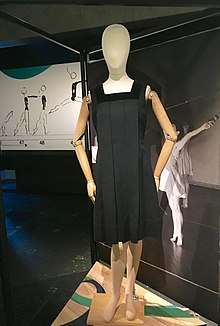Jumper (dress)
A jumper or jumper dress (in American English), pinafore dress or informally pinafore or pinny (British English)[1][2] is a sleeveless, collarless dress intended to be worn over a blouse, shirt, T-shirt or sweater.[3][4][5] Hemlines can be of different lengths and the type of collar and whether or not there is pleating are also variables in the design.[6]


In British English, the term jumper describes what is called a sweater in American English. Also, in more formal British usage, a distinction is made between a pinafore dress and a pinafore. The latter, though a related garment, has an open back and is worn as an apron. In American English, pinafore always refers to an apron.
A sundress, like a jumper, is sleeveless and collarless; however, such articles are not worn over a blouse or sweater, and are of distinctly different cuts and fashions. The apron dress may be viewed as a special case of the jumper. If the design of the dress is directly inspired by an apron (having a bib in front and ties in the back, for example), the garment is typically described as an apron dress.[7]
History
Jumpers for fall were described in The Fort Wayne Sentinel in 1906.[8] The dresses were "imported from Paris" and featured "original lines."[8]
Jumpers in the United States were part of the sportswear collections of Jean Patou, Coco Chanel and Paul Poiret.[6] Suzanne Lenglen wore Patou's jumper design in the 1920s.[6] The dresses, worn over blouses, became popular during the decade of the 1920s.[9] Jumpers were often worn in the summer and made out of various types of fabrics.[10]
Jumpers were touted as an "American" and a "sports fashion" in 1930 by the Pittsburgh Press.[11] The dresses were also praised for allowing women to create color combinations through the choice of blouse worn underneath.[11]
Jumpers were again popularized in 1953, when Hubert de Givenchy promoted his own jumper.[12] Jumpers, now considered a "classic" look, were considered "suitable to all ages."[13]
See also
- Gymslip – a British pinafore worn as athletic wear or school uniform.
- Kirtle – a medieval garment of similar function.
- Romper suit - Baby cloths.
- Sarafan – a Russian jumper women wear when in tall grass or more often, farming.
- Dirndl - an Austria version of it.
References
Citations
- Erin McKean The Hundred Dresses: The Most Iconic Styles of Our Time 2013 1408190508 "the jumper dress (known in the UK as a Pinafore dress) is a sleeveless dress intended to be worn over a blouse, shirt, or sweater. A Jumper may have a bodice with a completely closed back, or it may have a bib front, like a pair of overalls."
- "Hints for the Home Dressmaker". Chicago Tribune. 1906-11-11. p. 83. Retrieved 2018-02-09 – via Newspapers.com.
- Gavin Ambrose, Paul Harris The Visual Dictionary of Fashion Design 2940373612-- 2007 - Page 190 "Also called a pinny, a pinafore dress was intended to be worn over a top or blouse, but the name refers to any sleeveless dress that fastens behind. The name originates from the aprons that were pinned to the front of a dress."
- Jumper, definition in Collins American Dictionary
- "Pinafore" Oxford Dictionaries
- Marie, Jen (2 June 2015). "A Brief History Of The Jumper". Bustle. Retrieved 2018-02-09.
- Picken 1957, p. 101.
- "A New Model 'Jumper' Dress for Fall". The Fort Wayne Sentinel. 1906-09-10. p. 6. Retrieved 2018-02-09 – via Newspapers.com.
- Howell, Frances S.; Costilow, Christopher T. (2010). History of American Dress from the 15th and 16th Century Through 1965. Chris Costilow. p. 147. ISBN 9781450547383.
- Bottomley, Julia (1925-07-10). "Jumper Dress is Popular; In the Ultra Smart Mode". West Schuylkill Herald. p. 3. Retrieved 2018-02-09 – via Newspapers.com.
- Parrish, Amos (1930-10-14). "What's In Fashion: The Youthful Jumper Dress". The Pittsburgh Press. p. 26. Retrieved 2018-02-09 – via Newspapers.com.
- Snodgrass, Mary Ellen (2015). World Clothing and Fashion: An Encyclopedia of History, Culture, and Social Influence. Routledge. p. 75. ISBN 9781317451679.
- Blair, Beth (1957-03-07). "Classic Jumper Dress Is Suitable to All Ages". Courier-Post. p. 22. Retrieved 2018-02-09 – via Newspapers.com.
Sources
- Picken, Mary Brooks (1957). The Fashion Dictionary: Fabric, Sewing, and Dress as Expressed in the Language of Fashion. New York: Funk & Wagnalls Company.CS1 maint: ref=harv (link)
External links
| Wikimedia Commons has media related to Jumper dresses. |